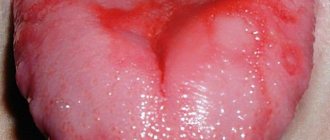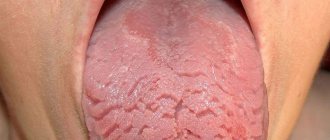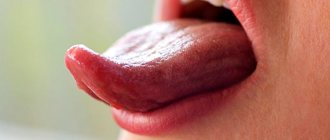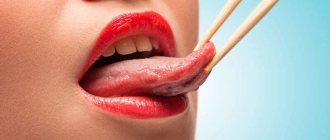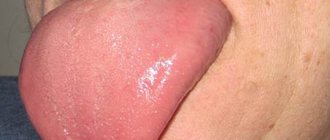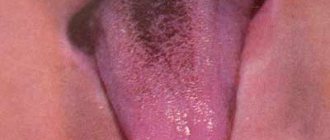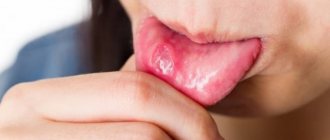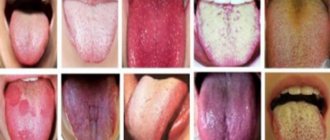1.General information
The apt, albeit somewhat frivolous name “geographic tongue” refers to the inflammatory-dystrophic process in the mucous membrane of the tongue, also known as “wandering glossitis”, “migratory oral erythema”, “exfoliative glossitis” (formulation in ICD-10), “desquamative glossitis”, etc. Exfoliative in translation means “flaky”, desquamative means “deprived of scales”, glossitis is inflammation of the tongue. Peeling of the epithelium in combination with inflammation and dystrophic changes together form red and white patterns on the tongue, which in many cases really resemble a fragment of a geographical map.
In different historical periods in medicine, there were different views on the essence and pathogenesis of desquamative glossitis (the term and concept were introduced into the medical paradigm in 1831), and the discussion continues to this day. Thus, some authors consider this process to be neurodegenerative, others to be purely inflammatory, and others generally consider it as a non-pathological variant of the norm.
The prevalence of “geographic language” varies significantly depending on the age, gender, and clinical composition of the studied samples; in terms of the general population, it is estimated at 2-5% of the population. There is a slight predominance of women, children and adolescents.
A must read! Help with treatment and hospitalization!
Write a comment
Svetlana
March 16, 2015 at 6:49 am
The cause of geographic tongue can indeed be several diseases. But mainly this is a problem of the gastric tract. And first of all, such an unpleasant disease as gastroesophageal reflux. This is when the contents of the stomach are thrown back into the esophagus and even the oral cavity. This can be complicated in addition bile reflux, when bile from the duodenum is thrown into the stomach and esophagus. So you should definitely contact a gastroenterologist, because if the disease becomes chronic, then it’s just torment, as it is accompanied by constant heartburn and burning in the esophagus and oral cavity. So that the most important thing is to start treating it right away; for this, the doctor will prescribe medications and a strict diet. So you should always monitor the child’s tongue.
Tatiana
May 30, 2015 at 11:04 am
In addition to rinsing with soda, chlorgrexidine lotions also help. In my case, this disease is caused by stress and manifests itself when the body is weakened - nervous overstrain or a cold.
Nadia
January 1, 2016 at 10:04 pm
Hello! My son is 3 years old. He has a geographic tongue. Our doctor always tells me to just rinse when I come. Spots appear periodically, and recently I began to notice that with the appearance of spots on my son’s tongue, his bowel movements are disturbed. But there are no complaints from him arrived.
Olga
August 28, 2016 at 6:15 pm
My son’s geographic tongue was noticed by a dentist during an appointment. I had never even heard of this before, and I didn’t know that, to be honest, there are different languages. Nothing bothered my son, there were no complaints. The dentist said that there is nothing wrong, the main thing is to find out the reason. Perhaps it’s untreated teeth, or a lack of vitamin B. We fixed all the teeth, and after a while I noticed that my son’s tongue became even.
Irina
September 4, 2016 at 12:19 pm
My sister also had a similar experience in childhood, but they did nothing, they didn’t even pay attention to this fact. As she grew older, everything disappeared; now her language is normal, like all other children. Therefore, I am inclined to conclude that with age, geographic tongue goes away on its own without any treatment. So there’s nothing to be afraid of, at least it’s passed for us.
Nata
February 8, 2022 at 0:02
My youngest had this condition of his tongue a couple of years ago, I noticed it by chance when I was brushing my teeth, but not as bad as in the pictures, there were smaller marks. I didn’t immediately understand what was wrong, I thought it was burned with something like acid, especially since before that I had complained a little about my stomach. We rushed to the doctor, it turned out to be worms, we were treated and everything went away, the tongue returned to normal. But the doctor also explained to me that such symptoms occur for various reasons, so if suddenly this appears on a child’s tongue, you don’t need to wait until it goes away on its own, but immediately consult a doctor.
2. Reasons
There is no single point of view regarding the etiopathogenesis of inflammatory desquamation of the tongue; the issue continues to be studied and discussed. According to the most reasoned hypotheses, the cause may be infections (both bacterial and viral), hereditary predisposition, diseases of the liver, pancreas, gastrointestinal tract (primarily gastritis, gastroduodenitis, peptic ulcer and intestinal malabsorption syndrome), endocrine and metabolic disorders, exudative diathesis in children, autoimmune diseases, helminthiasis.
Visit our Gastroenterology page
What does Dr. Komarovsky advise?
To cure your child faster, it is recommended to follow the doctor’s advice:
- Do not scratch or injure your tongue. During the treatment period, food should be soft , not hard. Spicy and too hot dishes are prohibited.
- The child should be prohibited from scratching his tongue. This can lead to wounds and complications.
- It is imperative to show the child to the doctor. Geographic language always signals larger problems .
- It is recommended to give the child vitamins or vitamin complexes. It is quite possible that the child has vitamin deficiency. This method will help restore the child's health.
- There is no need to rush to give your child serious medications . Usually vitamins and various lotions help to heal. Recovery occurs within two weeks.
3. Symptoms and diagnosis
The first manifestations are usually small, up to several millimeters, light gray lesions. Then such an area from the center turns red and swells somewhat, beginning to protrude above the surface and become covered with red papillary dots. The shape of desquamation foci can be very different, from round to arched. The alternation of inflamed, exfoliated and keratinized areas (usually they are multiple) forms a bizarre picture that can change quite quickly. The process is usually localized on the upper and lateral surfaces of the tongue, sometimes spreading to the lower areas.
In rare cases, desquamative glossitis causes subjective discomfort at the level of sensations - usually a burning or tingling sensation, less often pain when eating. In most cases, the disease is asymptomatic, for years or even decades; A recurrent (recurrent) type of course with long-term remissions is often noted.
To establish a diagnosis, an examination, collection of complaints (if any) and anamnesis are usually sufficient. However, given the importance of desquamative glossitis as a possible indicator of serious diseases, a multifaceted laboratory study is indicated (they begin with the appointment of general clinical and biochemical tests).
About our clinic Chistye Prudy metro station Medintercom page!
4.Treatment
In cases of asymptomatic disease, if there are no signs of underlying somatic diseases, therapy is not required and is not prescribed. The exception is the mandatory sanitation of problematic teeth and oral cavity, as well as normalization of the diet - which, however, is indicated for absolutely all people.
If there are symptoms of a particular disease that may be the cause or basis for the development of desquamative glossitis, the patient is referred to a specialist of the appropriate profile, where he receives etiopathogenetic treatment.
Black hairy tongue (lingua villosa nigra)
Black hairy tongue
Black hairy tongue, or lingua villosa nigra in Latin, is a generally painless and harmless condition characterized by the appearance of a black, moss-like coating.
The nature of the problem usually consists of two conditions - the papillae (taste buds) acquiring a blackish or brownish color and their growth in length. The black, hairy appearance of the tongue can be alarming and bothersome, especially when accompanied by bad breath and a feeling of nausea.
Causes
A black hairy tongue occurs due to the accumulation of bacteria, food debris, and other microorganisms on the papillae. The hairy appearance is therefore acquired as a result of the elongation of the papillae themselves when they are unable to rid themselves of accumulated debris. Why this happens is not entirely known, but here are some potential factors that may cause a black hairy tongue:
- insufficient and poor oral hygiene is the main cause of a furry tongue in many cases;
- excessive consumption of coffee along with frequent smoking of tobacco, including cigarettes;
- reaction to certain medications, e.g. those containing bismuth or antimicrobial components, such as tetracycline;
- regular use of mouthwash containing oxidizing and astringent agents such as methanol, witch hazel and peroxide;
- decreased saliva production or flow rate;
- black hairy tongue is also common in people without teeth, as they eat soft foods that are not abrasive to the surface of the tongue (soft foods do not remove dead cells);
- A weakened immune system, which may be caused by HIV/AIDS or diabetes, is also likely a factor;
- dry mouth.
Treatment
Usually, black hairy tongue goes away on its own, but you can speed up the process by eliminating some of the factors that may trigger its occurrence. During treatment, the goal is to restore the normal color or appearance of the affected tongue. Here are the best methods for treating black hairy tongue:
Regular brushing of teeth, mouth and tongue
Regular brushing of your teeth, gums and tongue with a soft-bristled brush will help get rid of accumulated bacteria and food debris on the tongue, hence preventing the problem from developing.
Moisturizing the mouth
You can prevent dry mouth by drinking enough water. Remember that when the oral cavity is not sufficiently moistened, the growth of bacteria and other microorganisms increases and their accumulation in the papillae. Therefore, keeping your mouth hydrated is very important.
